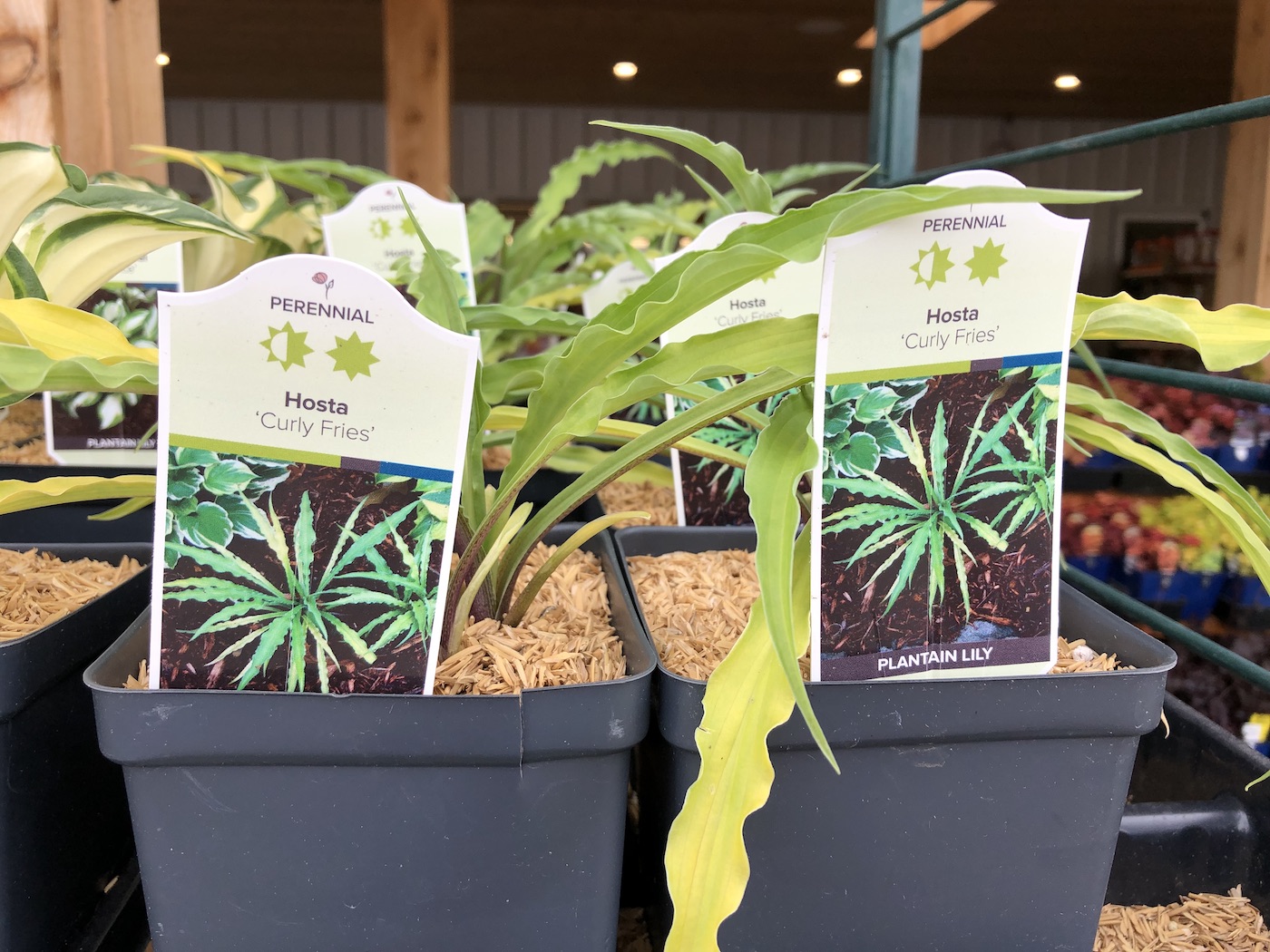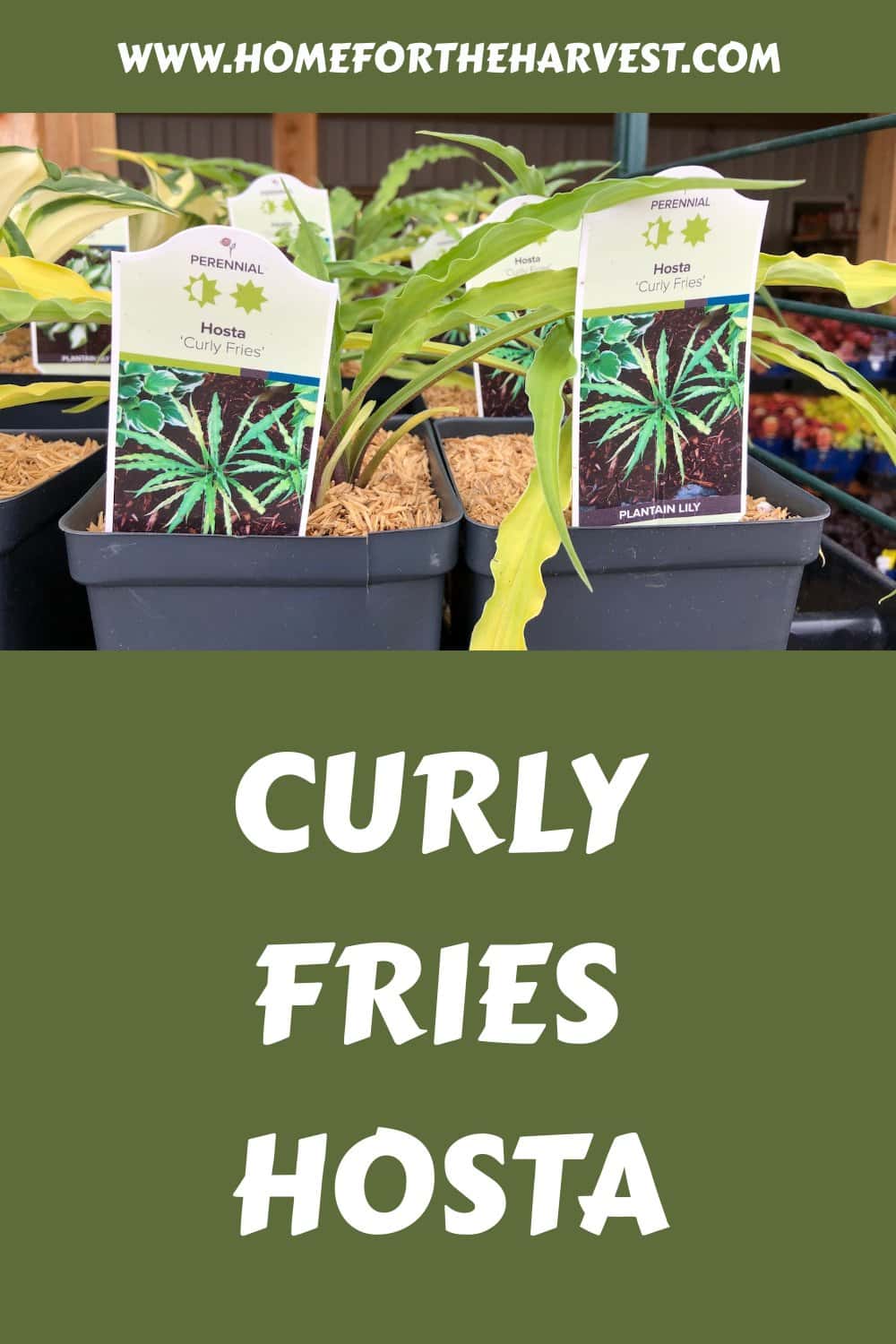Need a fun new hosta variety to add to your collection? Have a look at the Curly Fries!
The Curly Fries hosta is a small hosta variety with narrow, rippled, upright leaves in a bright chartreuse color. While this variety grows best in partial shade, it is sun-tolerant in cooler climates. Mature plants are about 6″ tall and 16″ wide, with lavender flowers in midsummer. Curly Fries hosta can be grown in zones 3-9 (provide afternoon shade in zones 8-9).
Introduction to Curly Fries hosta
Curly Fries hosta is a small variety of hosta known for its rippled, narrow leaves that resemble curly fries from a restaurant. The leaves of Curly Fries hosta are a bright chartreuse color with darker green margins. The ornate little flowers are delicately streaked with a rich lavender color. This variety is one of the more unique hostas to come on the market recently.
Hosta plants, including this variety, are generally quite easy to grow. This variety is sun-tolerant in cooler climates (typically zones 3-7) but does best in partial shade. The mature plant is 6″ tall and 16″ broad. I found that mine grew a little larger than this expected size, but it does get a bit of direct sunlight in the morning.
The Curly Fries hosta was bred by R. Solberg and introduced in 2008 (source: American Hosta Society.) It makes an excellent specimen hosta and is generally planted alone rather than in a mass groundcover planting.
Where to buy Curly Fries hosta plants
You can purchase Curly Fries hosta plants from many online retailers or from your local nursery. I had to check several different garden centers before I found mine, but it was worth the treasure hunt!
Be sure to look for a reputable seller with healthy plants. There are certain plant diseases (like Hosta Virus X) that are next to impossible to eradicate from your garden once they’ve snuck in on a diseased plant.
How to plant Curly Fries hosta
Curly Fries hosta is easy to grow and care for. Start by planting it properly and in the right location.
When and where to plant curly fries hosta
The best time to plant a hosta is in the spring, after the last frost date. This variety can be grown in USDA hardiness zones 3-9. Curly Fries will do best in partial shade but can tolerate full sun in cooler climates (zones 3-7). Afternoon shade is important in hotter areas. You’ll also have to increase watering frequency if your plant gets direct sunlight.
Preparing the planting site
First, choose a location for your Curly Fries hosta that meets the plant’s light requirements. If you are planting more than one hosta, space the plants about 16″ apart. They can be used in garden design in place of small ornamental grasses.
Next, prepare the planting site by loosening the soil. Remove any weeds, other plant debris, or large rocks that you find. Add some organic matter to the soil, such as compost or peat moss. This will help the plant roots to establish themselves and improve drainage. Here are some more tips for preparing great soil for planting hostas.
Planting your Curly Fries hosta
To plant your hosta, dig a hole that is twice as wide as the root ball but not deeper. Gently loosen the roots and place the plant in the hole so that the crown (where the leaves emerge) is at soil level. Backfill the hole with soil and water well.
Mulching Curly Fries hosta
Hostas benefit from a layer of mulch around the base of the plant. This helps to keep the roots cool and moist and also reduces weeds. Use organic mulch, such as chopped leaves, wood chips, or bark mulch. Don’t pile the mulch up against the stems of the plant though, as this can contribute to disease.
Plant care for Curly Fries hosta
Plant care in the first year or two mainly consists of watering regularly plus the possible application of fertilizer in spring and summer. Other than that, you’ll just have to snip off the dead flower stalks and any damaged leaves as they appear during the growing season. In the mid-late fall when the leaves yellow, you can cut the whole thing back to the ground.
Watering hostas
Water hostas regularly during the first growing season to help the plant roots establish themselves. After that, water as needed to keep the soil moist but not soggy. Curly Fries hosta is relatively drought-tolerant once established.
The best way to water this plant is right at the soil line. Avoid getting water on the leaves regularly. Good ways to water a hosta include using a soaker hose or drip irrigation. Overhead watering like a sprinkler is less effective and can also increase the incidence of disease.
Fertilizing Curly Fries hosta
Apply a balanced fertilizer for hostas to the plant in spring and summer. Follow the package directions for application rates and frequency. You can also use compost or other organic matter as a fertilizer.
Pruning Curly Fries hosta
Curly Fries hosta does not require pruning, but you can trim back any tattered leaves as they appear. You can also cut back the plant to its base in the fall after the first hard frost in the fall. Try to leave the leaves standing through early autumn though, as they are allowing the plant to store energy for next years sprouts.

Insects and diseases
Curly Fries hosta is generally resistant to pests and diseases. However, it can be susceptible to slugs, snails, and leaf spots. If you see any of these pests or diseases on your plant, it’s much easier to deal with these issues sooner rather than later.
Pest insects for hostas
Hostas are targeted by garden pests like slugs, snails, and Japanese beetles. These pests can cause serious damage to the plant if left unchecked.
Slugs and snails can be handpicked off at night with a flashlight or caught in beer traps. Japanese beetles can be controlled with organic insecticidal sprays or traps.
Diseases that affect hostas
Some of the diseases that can affect curly fries hosta include powdery mildew, rust, and leaf spot. These diseases are often caused by too much moisture on the leaves. Be sure to water at the soil line and avoid getting water on the leaves. If you see any of these diseases in your plant, treat them with an organic fungicide according to the package directions.
Powdery mildew is a white powdery fungus that can occur in humid conditions. It can be controlled with organic fungicides or by increasing air circulation around the plant.
Rust is a red or brown powdery fungus that can occur in humid conditions. It can be controlled with organic fungicides or by increasing air circulation around the plant.
Leaf spot is a brown or black spot that can occur on the leaves of curly fries hosta. It can be controlled with organic fungicides or by removing and disposing of affected leaves.






